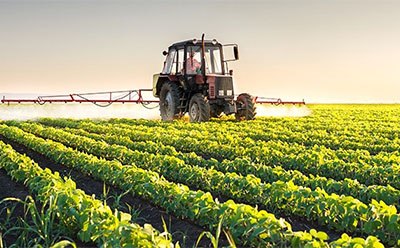Pesticide Standards

Pesticides are substances that are either chemical, biological agents (such as viruses, bacteria, antimicrobials, disinfectants, etc.) or a mixture of materials intended to prevent, destroy, repel or mitigate any pests. They are applied to eliminate targeted pests such as insects, rodents, weed, bacteria, plant pathogens, mollusks, nematodes (roundworms), mold, fungus, and any microbes that destroy property, cause nuisance, spread disease, or are vectors for diseases.
The residues from these pesticides can end up in the air, soil, water, and food. With our pesticide reference materials, you can accurately monitor soil, water, and food quality in accordance with national and international regulations.
Products
Related Product Resources
- Application Note: Analysis of Fipronil in Eggs
This document is an application note detailing a method for detecting fipronil, a banned insecticide, in eggs using QuEChERS extraction and GC/MS/MS analysis. The document outlines the background of the 2017 fipronil egg contamination incident, experimental setup, and results showing effective cleanup using Z-Sep+ sorbents.
- Application Note: UHPLC-MS/MS Analysis of Polar Pesticides on the Supel™ Carbon LC Column
The application note showcases the use of the Supel™ Carbon LC column for analyzing highly polar pesticides and their metabolites—such as glyphosate, chlorate, fosetyl-Al, and bialaphos—via UHPLC-MS/MS.
- Workflow for Pesticide Analysis in Cannabis
Complete workflow for cannabis flower pesticide testing using LC-MS/MS and GC-MS/MS ensures product safety.
- Brochure: Methods for Analysis of the California List of Pesticides in Cannabis (Analytix Reporter)
This PDF is Issue 10 of Analytix Reporter, a technical publication by Merck showcasing analytical innovations and applications. It features studies on porous graphitic carbon (PGC) columns for improved chromatographic separation, plasma protein binding comparisons using Supel™ BioSPME vs. rapid equilibrium dialysis, and methods for analyzing polar pesticides, pharmaceuticals in serum, and impurities in fingolimod.
- Analysis of California Cannabis List of Pesticides, Mycotoxins, and Pyrethrins Using Ascentis® Express Biphenyl Column
Cannabis testing regulations include analysis of purity, potency, and contaminants. Learn more about analysis of cannabis for pesticides, mycotoxins, and pyrethrins registered in California by LC-MS/MS and GC-MS/MS Using Ascentis® Express Biphenyl and SLB®-5ms Columns
- Flyer: Food Alert — Fipronil in eggs and egg containing products
This is a food safety alert highlighting the detection of fipronil—a banned insecticide in food-producing animals—in eggs across several European countries in 2017. It explains the health risk, outlines the EU's maximum residue level (0.005 mg/kg), and emphasizes the importance of accurate testing using certified reference materials.
- Flyer: Pesticide Reference Materials for Water Testing
The document provides information on pesticide reference materials for water testing, emphasizing the importance of monitoring pesticide residues and their metabolites in water sources to comply with European directives. It outlines environmental quality standards, priority substances, and vigilance lists for surface and groundwater monitoring.
- Flyer: Pesticide Reference Material for Food Testing
The document provides information on pesticide reference materials for food testing, highlighting their importance in ensuring compliance with European Union regulations on maximum residue levels. It covers the Multiannual Control Programmes for Pesticide Residues (MACP), applied to food of plant and animal origin from 2022-2024. The document lists pesticides to be determined in various food products, detailing their reference materials, quality grades, and certification standards. It emphasizes Merck's high-quality offerings, including ISO-certified and TraceCERT® materials for precise testing. Additionally, it provides guidance on ordering, technical assistance, and accessing the full pesticide standards portfolio.
- Flyer: Analysis of Banned and Other Neonicotinoids from Plant Material
- Flyer: TraceCERT® Pesticide CRMs
- Brochure: Gas Chromatography Tools for your workflow
The document outlines Merck's comprehensive solutions for gas chromatography (GC) workflows. It covers tools for proficiency testing, sample preparation, GC analysis, and detection/calibration. Highlights include certified reference materials, solvents, derivatization reagents, GC columns, and accessories tailored for various applications like environmental, pharmaceutical, and food testing.
Pesticide analytical standard grade (PESTANAL®)
PESTANAL® pesticide analytical standards are specifically designed for your routine analytics or screening tests, choose from our wide variety of neat or solution standards. Our range of neat pesticides comprises mother substances along with an increasing list of metabolites. To ensure the utmost transparency on your every purchase we provide a certificate of analysis with expiry date as well a product chromatogram.
Isotope labeled pesticides
Isotope dilution mass spectrometry (IDMS) is often applied to determine matrix effects and result bias owing to the loss of the analyte. This technique takes advantage of the fact that isotope labeled compounds have identical physical properties as the nonlabelled analogues. They can still be distinguished in mass spectrometry by spiking the sample prior to the workup process with an isotope labeled analogue, the material loss during workup can be easily determined and compensated. We offer a growing portfolio of both neat material and solutions, labeled as 13C, 15N, or D.
Pesticide reference material grade
Our pesticide reference material grade is certified under ISO/IEC 17025 for their property value using qNMR or mass balance approach. Hence, these reference materials assist you to achieve measurable, accurate, and traceable results.
Pesticide certified reference material grade (TraceCERT®)
Our rapidly expanding TraceCERT® product range consist of an increasing number of CRMs for pesticides, certified according to ISO/IEC 17025 and ISO 17034 and traceable to NIST SRMs. They can be utilized as calibration standards, internal or surrogate standards, spiking solutions, or laboratory control samples. The pesticides are accessible as neat material, single- or multi-component mixtures.
Pesticide metabolites
Modern pesticides once applied, tend to degrade rapidly due to both physicochemical and biotransformation. As a result, pesticide residues in samples might go undetected or get detected at very low concentrations. It is substantial to monitor pesticide metabolites in order to document their previous use. Our continuously expanding pesticide metabolite portfolio includes various quality grades (analytical standard, reference material, certified reference material), available in different formats (neat, solutions).
To continue reading please sign in or create an account.
Don't Have An Account?